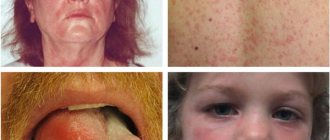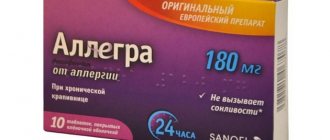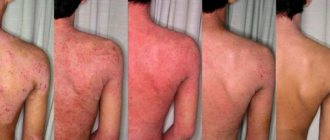Food allergy is one of the most common allergic conditions that develops due to intolerance to certain compounds in certain foods. In recent decades, doctors have noted an increase in the incidence of hypersensitivity to food, which is especially noticeable among the population of developed countries. This may be due to the variety of substances found in them. About half of people suffering from food allergies are children under 12 years of age, but the frequency of manifestations is already significantly increasing among adults.
Sensitization to allergens from food has a hereditary predisposition - many researchers talk about this. For example, Karataeva and Yusupova point out that “approximately half of patients suffering from food allergies have a burdened family or personal allergic history, i.e. either they themselves suffer from some allergic diseases (hay fever, atopic bronchial asthma), or these their closest relatives suffer from diseases” (Karataeva N.A., Karataeva L.A., Yusupova O.I., Inoyatova Sh.K., 2015, p. 128).
Causes of food allergies
There are several mechanisms for the development of allergies. But a significant proportion of cases are associated with type 1 hypersensitivity. It is explained by the release of immunoglobulin IgE and the activation of basophils. This reaction occurs in response to the entry into the digestive system of protein compounds recognized by immune cells.
Some predisposing factors are unique to children, others are also found in adults. Among the most common reasons are the following:
- Features of allergens in food. The reaction is most often provoked by antigens with high immunogenicity. They easily overcome the aggressive environment of the stomach. They are found in large quantities in whole milk, fish, eggs, cereals, strawberries, citrus fruits, and nuts.
- Hereditary predisposition. Food allergies are associated with hereditary characteristics of the body. They manifest themselves by increased reactivity, disruptions in the functioning of the immune system, as well as other mechanisms.
- Age-related features of the development of the digestive system. Children have high permeability of the stomach walls, and the acidity of gastric juice is lower than in adults. The composition of the microflora is also different. All this creates favorable conditions for the allergen to come into contact with immune cells.
The condition may be associated with the amount of food eaten and the characteristics of culinary processing. There are cases of so-called cross-allergy to pollen and household dust: some food products with similar compounds in their composition trigger an allergic reaction.
According to many researchers, the formation of allergies is facilitated by dietary violations during pregnancy, as well as early transfer of the child to artificial feeding. Gastrointestinal diseases, especially diseases of the liver, gallbladder, and biliary tract, also trigger and contribute to the exacerbation of allergies.
The most common causes of rashes on the legs:
- Clothes and shoes. Low-quality synthetic items, residues of powder or other household chemicals on pants, skirts, dresses. Clothes and shoes that are out of season, in which the feet “sore” - all this can lead to an allergic rash on the feet.
- Pet hair.
- Medicines, such as antibiotics.
- Food. The reaction most often occurs to exotic foods, sweets, etc.
- Dust mites living in upholstered furniture, toys, down pillows, thick curtains.
Foods and additives that cause allergies
Doctors Sidorovich and Luss write that “almost any food product can act as an allergen and cause the development of food allergies. However, the most pronounced sensitizing properties are in products of protein origin containing animal and plant proteins” (Sidorovich O.I., Luss L.V., 2016, p. 141). The table shows the most common allergens in food:
| Plant food | Raspberries, strawberries, wild strawberries, black currants, blackberries, pineapple, melon, persimmon, pomegranate, citrus fruits, chocolate, tomatoes, nuts, honey, mushrooms, wheat, soybeans, carrots |
| Animal food | Milk, eggs, fish, crustaceans and seafood, cold processed chicken |
| Supplements | Pesticide residues and agricultural fertilizers in plant foods. Dyes (especially tartrazine, erythrosine, sodium nitrite), flavorings (glutamates), preservatives (benzoates, benzoic acid, sulfites), enzymes, thickeners, emulsifiers, bacteriostatics, flavor enhancers (monosodium glutamate), etc. |
Note that allergen additives provoke so-called false reactions, or pseudo-allergies. In this case, food antigens can act without the participation of allergic antibodies on target cells or activate certain biological systems; they are not based on immune reactions.
An increase in the level of histamine in the blood may not be associated with a true allergy, but with the consumption of foods containing it in large quantities: fermented cheeses, sauerkraut, dried ham, canned food, spinach.
Symptoms of the disease
Food allergies often appear within a few minutes of consuming the product. There is a rash, itching, redness, swelling of the skin of the hands, face and neck. Many people complain of a sore throat, heartburn, and bloating. Children and adolescents are at high risk of anaphylactic shock, acute urticaria, eczema, and asthma.
In adults, the following symptoms most often develop:
- chronic urticaria;
- atopic dermatitis;
- rhinitis and conjunctivitis;
- gastritis;
- migraine;
- dermatitis.
According to statistics, skin manifestations are observed much more often. The rash is usually erythematous in nature. Elements of the rash can be located on any part of the skin. Dermatological manifestations persist from several hours to several days, then disappear on their own provided there is no further contact with the allergen.
When it enters the body again, the allergy develops again. There is a possibility that each episode will be more severe and intense.
Food allergies cause gastrointestinal problems within the first hours. The following symptoms are usually noted:
- stool disorders;
- abdominal pain, bloating;
- vomiting
With high allergic readiness, these symptoms develop already at the time of consumption of the allergen. It happens that dyspepsia is accompanied by immediate swelling of the mucous membranes of the mouth, lips, and tongue; nasal congestion.
Some varieties of fish, strawberries, and peanuts cause the most severe systemic reactions - angioedema, anaphylactic shock.
People suffering from bronchial asthma or food allergies often experience an attack that develops as a cross-allergy. Headaches, fatigue, and weakness appear after eating potentially dangerous foods.
Diarrhea due to food allergies
Researcher Kozyarin points out the high probability of diarrhea with food allergies: “If a person is not treated, then he may experience inflammation of the stomach and small intestine with abdominal pain and constant stool upset” (Kozyarin N.P., 2009, p. 66).
Allergies disrupt the frequency of bowel movements, with diarrhea observed for several days, which is often followed by constipation. This is not harmless, especially for people who already have intestinal problems.
Damage to the walls of the intestines and stomach leads to disruption of the processes of digestion and absorption of nutrients. If measures are not taken in a timely manner, thickening of the walls, a decrease in the intestinal lumen, and serious consequences in the form of persistent stool disorders and abdominal pain are possible.
An allergic reaction disrupts the balance of intestinal microflora . The mechanisms of influence of allergic processes on digestion are so diverse that independent gastroenterological diseases often develop, such as gastritis, peptic ulcers, and enzymatic deficiency in children. At the same time, treatment of these pathologies by a specialized specialist without adjusting the diet and taking measures to eliminate allergies is not always successful.
Diarrhea due to allergies can independently lead to complications - proctological pathologies, water-salt imbalance, and dehydration. Therefore, it is important to resort to symptomatic therapy before basic measures take effect.
Complications
The most severe complication from strong food allergens is anaphylactic shock. It develops due to hypersensitivity to certain foods or ignoring the first signs for a long time. The entry of an allergen into the human body leads to increased symptoms and further development of shock. The authors Pampura and Khavkin come to the conclusion that “in some patients, anaphylaxis appears only if physical activity is preceded by the consumption of a certain product” (Pampura A.N., Khavkin A.I., 2003, p. 1126).
If the allergy is manifested by vomiting and diarrhea, then prolonged contact with the allergen leads to electrolyte disturbances. They, in turn, often require correction in a hospital setting and also threaten human life and health.
Other complications include the addition of a bacterial infection when scratching the skin, the formation of cross-allergy to pollen or household dust.
Clinical researches
The effectiveness, safety and tolerability of the product for children and adults has been proven by a clinical study. The product is also suitable for daily skin care of children with mild to moderate forms of atopic dermatitis and during remission, accompanied by a decrease in the quality of life of patients. As a result of therapy, a decrease in the activity of the inflammatory process, a decrease in dryness, itching and flaking was noted.
La-Cri cosmetics, according to research results, are recommended by the Russian Union of Pediatricians.
Sources:
- Fokina R.A., Atopic dermatitis: stages of development of classification forms, Siberian Medical Journal, 2007 https://cyberleninka.ru/article/v/atopicheskiy-dermatit-etapy-razvitiya-klassifikatsionnyh-form
- A.N. Pampura, A.A. Chuslyaeva, Modern approaches to the treatment of atopic dermatitis in children https://cyberleninka.ru/article/v/sovremennye-podhody-k-terapii-atopicheskogo-dermatita-u-detey
- Yukhtina N.V., Modern ideas about atopic dermatitis in children https://cyberleninka.ru/article/v/sovremennye-predstavleniya-ob-atopicheskom-dermatite-u-detey
First aid for food allergies
They independently provide first aid for allergies to food additives, if the person’s life and health are not in danger.
What symptoms indicate a direct threat:
- breathing problems;
- swelling of the neck, tongue;
- altered speech;
- confusion.
All of the above is a reason to call an ambulance . If an allergic reaction appears for the first time, even without symptoms that threaten health, it is necessary to get medical help as soon as possible, especially if we are talking about a child.
If symptoms are not expressed, it is permissible to take the first measures yourself. The following categories of drugs are used for this:
- Sorbents. They allow you to bind and remove harmful substances from the gastrointestinal tract. Such drugs accelerate the elimination (removal) of allergens, alleviate the condition and speed up recovery.
An effective product from this group is Fitomucil Sorbent Forte, which contains the shell of psyllium seeds, as well as the prebiotic inulin and a complex of live probiotic bacteria. Psyllium seed husk is a natural soluble fiber that absorbs water and allergens into a mucilaginous gel. The drug does not irritate the intestinal walls, gently stops diarrhea, promoting thickening of stool.
- Antihistamines. Today there is a wide range of new generation medications that do not have side effects such as drowsiness and are well tolerated. It is better to choose medications from those you have already taken before, or consult a doctor.
For skin manifestations, it is possible to use local agents with antihistamine and soothing, antipruritic effects. Severe allergies, manifested by severe redness and itching of the skin, will most likely require the use of local hormonal ointments and creams.
But remember that they are prescription drugs and cannot be used for longer than the time prescribed by the doctor - usually about 7-10 days for mild to moderate cases. Hormonal drugs for oral administration or injection also require a prescription from a specialist who will develop a suitable regimen for use.
Developed vomiting and diarrhea require action. Taking sorbents will help in the second case, and in case of uncontrollable vomiting, you should seek emergency help. If vomiting and diarrhea occur sporadically, several times a day, it is necessary to replenish fluid loss with the help of special rehydration solutions - pharmacy or self-prepared.
It is necessary to drink enough fluids to prevent dehydration and the occurrence of associated disorders. Kozyarin suggests using herbal tea, decoctions of plants: “chamomile, St. John’s wort, calendula, calamus, valerian” (Kozyarin N.P., 2009, p. 66).
To prevent allergic rashes on the legs, it is recommended:
- Wash your feet in cool water using gentle detergents;
- After any water procedures, thoroughly wipe the space between the toes - this will prevent the occurrence of foot fungus;
- Wear shoes and clothes made from natural materials;
- Use an ointment or cream with an anti-inflammatory effect prescribed by a dermatologist;
- Apply a moisturizing cream to your feet, such as La Cree healing cream. It will not only relieve inflammation, itching, speed up the regeneration process if rashes have already appeared, but will also prevent their occurrence. The cream perfectly moisturizes the skin without leaving an unpleasant sticky film on the body. Thanks to natural ingredients and the absence of hormonal elements in the composition, La-Cri cosmetics are recommended even for children. The cream is sold only in pharmacies and meets international quality standards.
Treatment
The course of treatment can be divided into two parts: the use of medications when symptoms immediately appear and therapy aimed at prevention. Doctor Luss o (Luss L.V., 2005, p. 140).
Antihistamines are not a panacea, since both with true allergies and with pseudo-allergies, it is important to promptly eliminate risk factors for the development of severe manifestations.
The main ones include concomitant diseases of the gastrointestinal tract, leading to failure of the digestion process, changes in the permeability of the walls of the gastrointestinal tract, and a decrease in the acidity of gastric juice. For this purpose, enzyme preparations, enterosorbents, and probiotics are used.
The most important point after the first measures is to accelerate the elimination of the allergen and prevent further contact with it. The main stages of treatment look like this:
- Symptomatic therapy: taking antihistamines for first aid.
- Elimination of the allergen from the body: prescribing a hypoallergenic diet, pharmacological methods, or a combination of these approaches. If the “provocateur” entered the digestive system recently (several hours ago), enterosorbents will be especially effective. They bind substances in the intestinal lumen, preventing them from further entering the bloodstream. If allergens have been in the body for a long time or a lot of time has passed after a single exposure, elimination occurs naturally, and sorbents will only help in eliminating symptoms.
- Allergen-specific immunotherapy (ASIT). This stage follows only after elimination, comprehensive diagnosis, and accurate identification of the provoking antigen.
ASIT is relevant when irreplaceable dishes are added to the list of those prohibited for consumption; the human body is not provided with everything necessary. This method consists of introducing certain dosages of the allergen, which are gradually increased, which allows the development of immunological tolerance.
Author Luss emphasizes that “the attitude towards ASIT in patients with IPA is not yet clear and contradictory. Basically, preference is given to prescribing elimination diets” (Luss L.V., 2005, p. 140). Perhaps this is due to the need to undergo comprehensive diagnostics and constant long-term treatment when the allergy no longer manifests itself. After all, ASIT can be recommended six months after changing the diet. However, this method is the only option to get everything you need from food when you have allergies.
Nutrition for food allergies
The complex of therapeutic measures necessarily includes a nutritional method. Eliminating the cause—the antigen—is extremely important to improve the condition and prevent exacerbations. A complete avoidance of intolerant foods is expected. For convenience, we have provided a list of permitted and prohibited items in the table:
| Allowed | Prohibited |
| Unfortunate bread | Smoked meats |
| Tea | Vinegar |
| Sugar | Fish |
| Boiled lean beef | Mushrooms |
| Butter and vegetable oils | Bird |
| Fresh cucumbers | Nuts |
| Parsley dill | Whole cow's milk |
| Watermelons | Honey |
| Baked apples | Nuts |
| One-day fermented milk products | Fruits and berries: strawberries, melon, pineapple, citrus fruits |
| Cereals: rice, buckwheat, oatmeal | Vegetables: eggplant, radish, horseradish |
Fasting is strictly prohibited for people with chronic diseases, blood diseases, malignant neoplasms, sore throat, other respiratory diseases, liver and circulatory diseases in history.
You will need to limit or eliminate ready-to-eat cereals, pasta (without eggs), ready-made pies, gingerbread cookies, colored marshmallows, and caramels due to the tartrazine they contain. It is necessary to limit the consumption of wine, beer, fruit juices, gelatin, baking mixes, marinades, and most prepared sauces, as they contain sulfites.
There are different options for therapeutic nutrition:
- Grain-free diet. Involves avoiding cereals, flour products, seasonings, and sauces. Preference is given to meat, vegetables, fruits, and dairy products.
- Egg-free diet. Excludes eggs, seasonings, mayonnaise, sauces and creams, pasta, baked goods containing eggs. The diet consists of meat, dairy products, cereals, vegetables, and fruits.
- Dairy-free diet. Milk, milk porridge, cottage cheese, confectionery, and butter are excluded from the diet. The menu is based on dishes of meat, fish, eggs, cereals, vegetables and fruits.
- Diet excluding milk, cereals, eggs.
Thus, it is not necessary to give up all possible allergens. When you consult a doctor, you will receive accurate recommendations. It is important to make your own assumptions about what exactly could have been the source of unpleasant manifestations.
Keeping a diary will help determine which food allergens could cause a response and which ones are not perceived aggressively by the body. At the same time, you should write down not only everything you eat during the day, but also the cooking methods. Note exactly what manifestations of allergies are observed: skin itching, stool disorders, redness of the skin, nausea.
The main feature of nutrition for allergies is not simply to refuse a certain food, but to find an adequate replacement. The diet must remain balanced, otherwise severe restrictions are likely to lead to vitamin and mineral deficiencies. If you are forced to completely give up milk and eggs, your diet should include a variety of meat and fish dishes. It is better to search for alternatives together with your doctor.
Dermatitis on legs
Venous dermatitis on the legs
Varicose dermatitis on the lower legs occurs as a result of trophic disorders.
It develops against the background of chronic uncompensated lymphovenous insufficiency.
Women suffer from this pathology 3 times more often than men.
Pathology usually occurs after 40 years.
Venous dermatitis often occurs on the legs during pregnancy.
This is due to an increase in the volume of circulating blood and a decrease in the tone of the veins due to hormonal changes.
The pregnancy hormone progesterone increases the permeability and distensibility of the venous wall.
Which leads to varicose veins and deterioration of blood supply to the skin of the lower extremities.
Varicose eczematous dermatitis on the legs does not develop instantly.
If the cause is not thrombosis or injury, and the pathology occurs against the background of varicose veins, then this process lasts for years.
Its appearance is promoted by venous stagnation.
Initially, signs of skin thickening appear, hair falls out, and swelling is observed.
Only after some time does stasis dermatitis occur.
Upon examination, the doctor discovers dilated veins.
The skin is atrophic, dry, thin, hyperpigmented.
Varicose eczema can spread to other parts of the body as the body becomes sensitized.
White plaques may appear on the skin.
Against their background, varicose ulcers develop - they are very painful.
In vascular dermatitis on the legs, the subcutaneous tissue is thickened.
Against this background, warty growths of the epidermis are possible.
Dry dermatitis on legs
Older people often develop dry dermatitis.
At risk are men over 65 years of age.
Pathology most often occurs in the winter season, while remission is observed in the summer.
The main localization of this type of dermatitis is the lower legs.
Upon examination, the doctor discovers dry skin.
Peeling is possible.
The disease has a chronic, long-term course.
The inflammatory process can last from several weeks to several months.
Very often, the disease develops against the background of constant degreasing of the skin - regular washing with soap.
Dry warm air also contributes to dry dermatitis.
To prevent the occurrence of the disease, older people should avoid frequent use of soap.
You should bathe more often in the shower rather than in the bath.
And also maintain the air humidity in the room where they spend most of their time at a level of at least 50%.
Seborrheic dermatitis on the legs
Seborrheic dermatitis occurs in areas where there is hair.
There are quite a lot of them on the legs, so the lower limbs are at risk.
Pathology can occur in people of any age, including children.
Men get sick more often.
Seborrheic dermatitis is not genetically transmitted, but there is a hereditary predisposition to it.
This disease is chronic with an undulating clinical course.
Periods of exacerbation and remission follow each other.
Usually there is an improvement in the summer, and an exacerbation in the fall.
People who suffer from seborrheic dermatitis are better off wearing shorts rather than trousers in the warmer months.
Because ultraviolet rays reduce the manifestations of the disease and prevent exacerbations.
Typically, the rash elements of seborrheic dermatitis look like greasy or dry patches with peeling.
These can also be large papules measuring 1-2 cm, with clear boundaries.
It may become wet and cracks may appear.
Infectious dermatitis on the legs
Sometimes skin inflammation is caused by infections.
The causative agents can be fungi, bacteria, viruses.
Frequent causative agents of skin infections are staphylococci and streptococci.
Infectious dermatitis may be accompanied by suppuration.
Upon examination, the doctor discovers:
- purulent crusts;
- continuous arrangement of morphological elements of the skin without layers of healthy skin;
- increase in lesions along the periphery;
- the presence of single papules or pustules around the main focus of infection.
There are a wide variety of infections that can affect the skin.
In each case, the symptoms will be different.
How to treat dermatitis on the legs
Treatment for dermatitis on the legs can vary depending on the type of disease.
Acute simple contact dermatitis (the result of a chemical burn) usually goes away on its own.
Treatment is not required - the manifestations of the disease disappear without any residual effects.
But in severe clinical cases, medical assistance may be needed.
It consists of treating the affected skin with antiseptic solutions.
This is required to prevent the addition of bacterial inflammation.
If there are large bubbles, they are punctured, but the tire is not removed.
To reduce symptoms - pain, itching, burning, swelling - weak local glucocorticoids are prescribed.
For severe inflammation, oral corticosteroids are prescribed.
For acute allergic dermatitis, the treatment is similar.
It is important to identify the allergen and avoid contact of the skin of the feet with it.
In cases of subacute or chronic allergic dermatitis, ointments with potent glucocorticoids are prescribed.
Oral corticosteroids may be used.
With atopic dermatitis, the main goal of treatment is to avoid further scratching of the skin.
Lotions with camphor or menthol help relieve itching.
These drugs have a distracting effect.
In the acute stage, ointments with corticosteroids are used to treat atopic dermatitis.
To prevent the addition of a secondary bacterial infection, use local medications with antibiotics.
For severe itching, take oral antihistamines.
When a secondary bacterial infection occurs, antibiotic tablets are prescribed.
It is possible to use intestinal sorbents internally to remove toxic metabolic products.
In the treatment of cold dermatitis, plasmapheresis is used to cleanse the blood of circulating immunoglobulins.
For kidney damage, cyclophosphamide is prescribed.
For inflammation of the skin and joints, non-steroidal anti-inflammatory drugs are indicated.
Treatment of venous dermatitis on the legs is carried out with the help of hormonal drugs.
Triamcinolone is administered locally.
It is important to avoid injury to the affected areas.
Treatment of the underlying disease – varicose veins – is required.
Sclerotherapy or surgery can be used for this.
Before radical treatment, a person wears tight bandages for the treatment of blood vessels or compression stockings, and takes venotonics (diosmin).
In the treatment of dry dermatitis, effective ointments containing vegetable oils are used.
You should install a humidifier in the bedroom.
You can take warm baths with added oils.
Foretal cream gives good results.
In cases of severe inflammation, corticosteroids of moderate strength are used.
They are used 2 times a day.
Hormones are canceled after the cracks in the skin disappear.
In the treatment of seborrheic dermatitis on the legs, drug and non-drug methods are used, depending on the severity of the pathology.
The patient is advised to spend more time in the sun.
Irradiation with an ultraviolet lamp can be carried out.
When a fungal process is attached, creams with ketoconazole are used.
Corticosteroid ointments (hydrocortisone) 2 times a day may be prescribed.
For maintenance therapy, 2% salicylic acid is used.
Non-hormonal cream Naftaderm is used.
Hydrocortisone may also be prescribed for maintenance treatment.
But in this case, regular medical examinations are required in order to promptly identify signs of incipient skin atrophy.
In the case of infectious dermatitis, identification of the pathogen is required
Then treatment is carried out with antibiotics, antimiotics or antiviral drugs.
The lesion is treated with antiseptic solutions.
For suppuration, broad-spectrum antibiotics (erythromycin, ceftriaxone, etc.) are indicated.
Alternative treatment for dermatitis on the legs
Some patients try to treat at home with folk remedies.
This approach is doomed to failure.
In folk medicine, all dermatitis is treated with the same means - without any diagnosis.
In addition, all the recipes used are ineffective.
In the best case, a person will be lucky and the dermatitis will go away on its own.
At worst, complications will arise as a result of an allergy to folk remedies or the spread of an infectious process.
Many dermatitis are dangerous to human health and life.
Therefore, treatment should only be done by a doctor.
What tests should I take?
It is not always possible for a doctor to clinically determine the origin of dermatitis.
After all, many inflammatory processes have similar external manifestations.
Therefore, tests are often required for dermatitis.
Basic laboratory tests that are used:
- Skin patch tests with allergens - to confirm allergic contact dermatitis.
- Allergic blood tests for immunoglobulins E.
- Scraping for fungus.
- Culture for infections.
- Dermatoscopy.
- Skin biopsy.
- Doppler testing of blood vessels for suspected varicose veins.
Which doctor should I contact?
If signs of dermatitis appear, you should consult a dermatologist or dermatovenerologist.
This specialist deals with skin diseases.
Good dermatologists work in our clinic.
You can contact one of them.
The doctor will find out the cause of dermatitis, its origin, and conduct targeted therapy.
It will be aimed not only at eliminating the symptoms of pathology.
But also to eliminate the main pathogenetic and etiological factors that led to inflammation.
This is required to ensure that dermatitis does not return in the future after treatment is completed.
If dermatitis appears on your legs, contact the author of this article, a dermatologist in Moscow with 15 years of experience.







